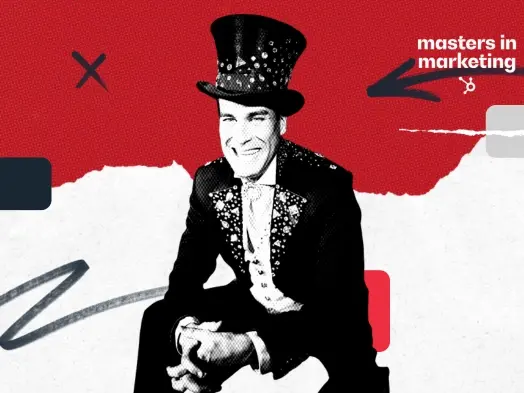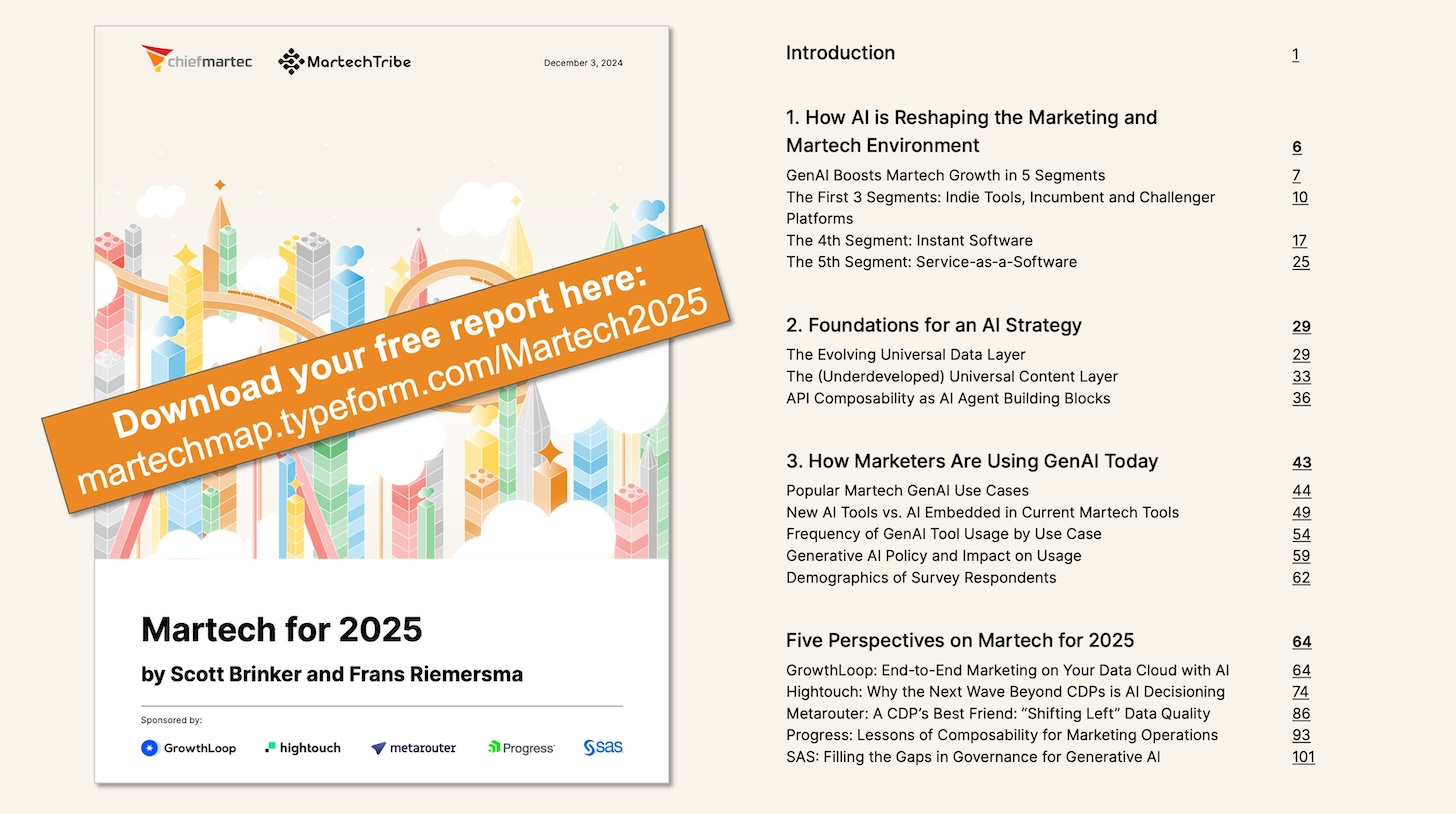
Happy holiday season, ye merry marketing maestros!
Here’s a marvelous way to get prepped and psyched for the New Year that’s right around the corner. Frans Riemersma and I just released our latest report, Martech for 2025. It’s 108 pages of our latest research and analysis of what’s actually happening with marketing technology in the maelstrom of AI madness.
No heaps of hype. Just hard data and a hopefully helpful framing of the facts.
You can pick up a free copy here.
Here’s a quick peek at some of what’s inside…
One of the topics we cover is the evolving structure of the martech industry in the AI era and how that’s changing marketing tech stacks and marketing operations with it.

At the center of the commercial martech landscape, incumbent products and platforms have been rapidly adding new AI capabilities. We call this “embedded AI” because it works in the existing tools and workflows you already have in place.
But there’s also a flood of thousands of new AI-native martech products. Most are “indie” tools in the long tail of the martech landscape. They tend to specialize in one thing, or a few things, primarily in content production, data analysis, personal productivity, or simple AI agent automation.
The majority of these tools are complementary to existing incumbent platforms. Indeed, the marketplaces around major platforms such as HubSpot, Salesforce, and Shopify have seen significant growth in the number of AI app integrations listed in recent months.

Of course, some newcomers are more competitive than complementary to the existing market leaders. These AI-native “challengers” have the advantage of a blank sheet of paper upon which to reinvent their respective martech categories — but are at a serious disadvantage against the dominant position of widely-adopted incumbents.
So it ever was. As Alex Rampell stated 9 years ago, “The battle between every startup and incumbent comes down to whether the startup gets distribution before the incumbent gets innovation.” The race is on.

So where are marketers leveraging AI embedded in their existing products and platforms, and where are they experimenting with new indie tools or challengers?
The centerpiece of our Martech for 2025 report is one of the most in-depth studies of gen AI use cases in marketing today. It’s changing quickly, but this is a snapshot of over 50 marketing use cases with data on which are being used frequently or infrequently — and for which use cases are marketers leveraging embedded AI in existing tools or turning to new AI tools.

From a quick glance, you can see that many of the use cases for new AI tools revolve around content production and new ways of engaging with data, especially unstructured “knowledge” data. Gen AI use cases embedded in existing tools naturally flow into current work with meetings, email, campaign optimization, personalization, etc.
Notably, a number of marketers report using both embedded AI and new AI tools in many of these categories. Good! It’s a great time to be experimenting and learning what is possible across your tech stack.
But there’s more happening beyond commercial SaaS products in the martech landscape.

There’s the new model of “service-as-a-software” — a clever play on the SaaS acronym. Instead of paying for seats or compute/storage use, where it’s up to the buyer to wield those tools successfully to achieve the outcomes they’re seeking, a new generation of AI agents are being offered on a cost-per-outcome basis.

AI customer service bots are the most popular example, such as Sierra.ai. Or in B2B marketing and sales, AI agent SDRs and BDRs, such as 11x and AiSDR. (Although there are some reservations about that experience, depending on how it’s deployed.)
We’ve advocated for many years about the blending of software and services to best help marketers achieve their goals. This emerging generation of service-as-a-software offerings is a promising model to deliver that.
But the even larger change we see is the explosion of custom apps being created with explicit — or more revolutionary implicit — software development with AI co-pilots and agents. This is the AI-ification of low-code/no-code capabilities that have been empowering IT, marketing operations professionals, and “citizen developer” power users to build their own specialized apps and automations.

AI coding co-pilots have already dramatically accelerated the creation of software by professionals. Google recently said 25% of their new code has been written by AI.
No-code tools are also gettig the AI treatment, making it easier than ever for non-developers to create their own apps, workflows, and web experiences. While there are thousands of commercial martech apps, these AI-powered low-code/no-code platforms enable millions of such custom apps.
But that’s about to be dwarfed by AI agents that will build software programs at the behest of users without those users even realizing it.
Here’s a simple example of such “instant software.” I asked ChatGPT to create a chart for me of stock market data. It complied in a matter of seconds. However, when I clicked on the little icon to see exactly how it created that chart, it showed me that it wrote a Python program and executed it on my behalf. I didn’t ask it to write a software program. If I hadn’t clicked to get more details on the chart, I wouldn’t have even known that a Python program had been written or executed. But one was.

We could have a fun philosophical debate about whether AI agents figuring out how to accomplish requests made by users constitutes actual software development. But when you can see the Python code that the AI wrote, it’s hard to argue that it’s not software. It’s just not visible software.

It’s the final stage of the democratization of marketing technology, where a whole class of martech capabilities becomes ambient and automatic.
Is this incredibly exciting? Yes. Is it also somewhat terrifying? Yes.
Governing and orchestrating this new AI-powered environment is going to be a massive challenge. Or, more positively, a massive opportunity. We’ve been anticipating this as the rise of Big Ops — a nod to the analogy of Big Data — where it’s the volume, velocity, and variety of apps, automations, and AI agents, all running in parallel, across our burgeoning digital operations.

This is just a brief sample of what we cover in Martech for 2025, so please pick up a copy.
Ah, but wait — there’s more!
The research Frans and I have spent the past 5 months working on has been supported by five terrific sponsors. While they had no say in our editorial, we tapped their expertise for a series of candid interviews on AI and data topics in martech that they’re on the pioneering frontier with the work they’re doing.
These aren’t sales pitches. They’re perspectives from five really smart leaders shaping our industry, which we’ve included in the report. We think you’ll find them as fascinating as we did:
Chris O’Neill, CEO of GrowthLoop
End-to-End Marketing on Your Data Cloud with AI
Tejas Manohar, CEO of Hightouch
Why the Next Wave Beyond CDPs is AI Decisioning
Greg Brunk, Head of Product at MetaRouter
A CDP’s Best Friend: ‘Shifting Left’ Data Quality
Sara Faatz, Director, Technology Community Relations at Progress
Lessons of Composability for Marketing Operations
Jonathan Moran, Head of Martech Solutions Marketing at SAS
Filling the Gaps in Governance for Generative AI
A few good hours of reading awaits you here. As does an amazing 2025 ahead!
Get chiefmartec.com directly in your inbox!
Subscribe to my newsletter to get the latest insights on martech as soon as they hit the wire. I usually publish an article every week or two — aiming for quality over quantity.










